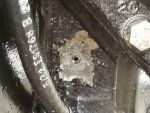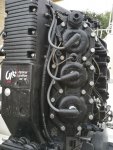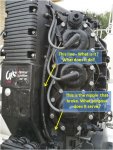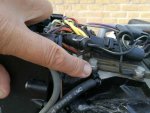Today I was cleaning my 1999 Ocean Pro 150 in preparation for sanding and painting. I removed the port and stbd side covers and was de-greasing the power-head with a parts cleaning brush and a tooth brush I was using the toothbrush when I knocked a small brass port connected to a piece of tubing that connected the upper and lower portions of the block There was a lot of aluminum pitting around the fitting. I don't think I should have been able to break it off with a toothbrush.
Anyway, my next question is what part is this (I guess a vacuum port but I can't find it on parts diagrams) and how hard is this to change. Also what is the best approach to take. I am assuming an easy-out? I really don't want to mess it up and I'm hoping to benefit from the experience of someone who has done this before. Any advice?
Pictures below
Anyway, my next question is what part is this (I guess a vacuum port but I can't find it on parts diagrams) and how hard is this to change. Also what is the best approach to take. I am assuming an easy-out? I really don't want to mess it up and I'm hoping to benefit from the experience of someone who has done this before. Any advice?
Pictures below























